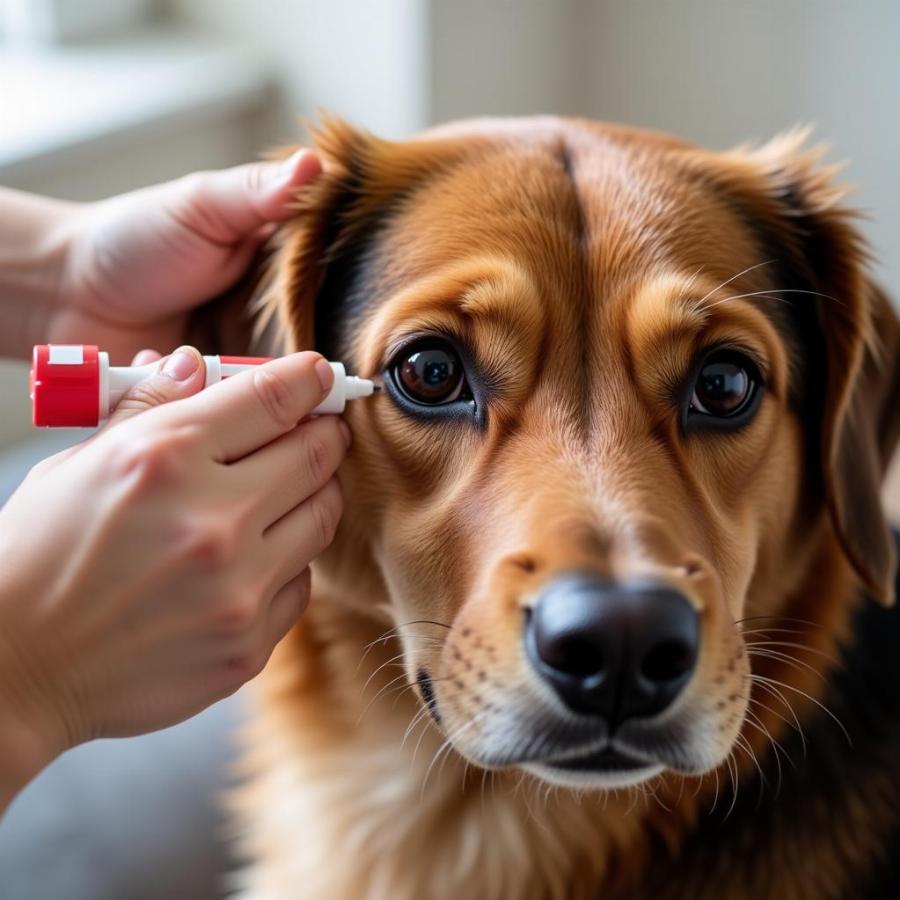Cataracts in dogs can be a worrying experience for any pet owner. Understanding the role of dog cataract eye drops and how they fit into overall cataract management is essential. This comprehensive guide explores the different types of dog cataract eye drops, their uses, potential side effects, and when to consult a veterinarian. We’ll cover everything from preventative measures to post-surgical care, ensuring you’re well-equipped to handle this common canine eye issue.
Understanding Canine Cataracts and the Role of Eye Drops
Just like in humans, cataracts in dogs occur when the lens of the eye becomes cloudy, affecting vision. While some cataracts progress slowly, others can develop rapidly, leading to significant vision impairment. Dog cataract eye drops play a crucial role in managing this condition, offering both preventative and supportive care. They can help slow cataract progression, reduce inflammation, and alleviate discomfort. However, it’s important to remember that eye drops are not a cure for cataracts. Surgery remains the only definitive treatment for restoring vision in dogs with significant cataracts.
 Dog with Cataracts Receiving Eye Drops
Dog with Cataracts Receiving Eye Drops
Different Types of Dog Cataract Eye Drops
Several types of dog cataract eye drops are available, each serving a different purpose:
- Anti-inflammatory Eye Drops: These drops help reduce inflammation and redness associated with cataracts. They are often prescribed after cataract surgery to prevent complications.
- Antioxidant Eye Drops: These drops contain antioxidants that can help protect the lens from further damage and potentially slow cataract progression. They are often used as a preventative measure in dogs at risk of developing cataracts.
- Lubricating Eye Drops: These drops help keep the eyes moist and comfortable, especially in dogs with dry eye, which can sometimes accompany cataracts.
When to Seek Veterinary Care
If you suspect your dog has cataracts, it’s crucial to consult a veterinarian. Early diagnosis and treatment are essential for managing the condition effectively. Signs of cataracts in dogs can include cloudy pupils, difficulty navigating familiar surroundings, and changes in eye color.
Administering Eye Drops Correctly
Proper administration of dog cataract eye drops is crucial for ensuring their effectiveness. Here’s a step-by-step guide:
- Wash your hands thoroughly.
- Gently restrain your dog.
- Tilt your dog’s head back slightly.
- Pull down the lower eyelid to create a small pocket.
- Place the prescribed number of drops into the pocket, avoiding contact between the tip of the bottle and the eye.
- Allow your dog to blink naturally to distribute the drops.
Post-Surgical Care and Eye Drop Usage
cataract eye drops for dogs are often prescribed after cataract surgery to prevent infection, control inflammation, and promote healing. Following your veterinarian’s instructions regarding post-surgical eye drop administration is crucial for a successful recovery.
FAQs About Dog Cataract Eye Drops
1. Can dog cataract eye drops cure cataracts? No, eye drops cannot reverse existing cataracts. Surgery is the only effective treatment for restoring vision.
2. Are there any side effects associated with dog cataract eye drops? Some dogs may experience mild side effects such as temporary redness or irritation. Consult your veterinarian if you notice any adverse reactions.
3. How long should I use dog cataract eye drops? The duration of treatment depends on the specific condition and the type of eye drops prescribed. Always follow your veterinarian’s instructions.
4. Can I use human cataract eye drops on my dog? Never use human medications on your dog without consulting a veterinarian. Human eye drops can be harmful to dogs.
5. How can I prevent cataracts in my dog? While not all cataracts are preventable, maintaining a healthy diet, regular veterinary check-ups, and protecting your dog’s eyes from UV radiation can help reduce the risk.
Preventing Eye Issues in Dogs
Beyond cataracts, maintaining overall eye health is crucial for your dog’s well-being. Regular eye exams, a healthy diet, and eye flush for dogs in case of irritants can contribute significantly to preventing various dog eye issues pictures might depict.
Conclusion
Dog cataract eye drops are a valuable tool in managing canine cataracts, providing comfort and support. However, they are not a substitute for veterinary care. dog cataracts eye drops play an essential role in supporting eye health, and understanding their function is crucial for every responsible dog owner. Always consult with your veterinarian for accurate diagnosis and treatment recommendations. Early intervention is key to preserving your dog’s vision and quality of life.
Beaut Dogs is your one-stop resource for all things related to dog care. We offer expert advice, insightful articles, and a wealth of information to help you provide the best possible care for your canine companion. When you need assistance, please contact us via Email: [email protected] to receive detailed and accurate responses from Beaut Dogs. Visit us today at Beaut Dogs to learn more.